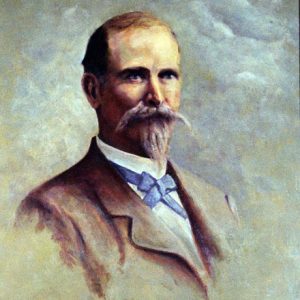calsfoundation@cals.org
Reconnaissance from Pine Bluff (July 13–14, 1864)
The July 13–14, 1864, reconnaissance from Pine Bluff was conducted to determine the locations of Confederate troops in the area and gather forage for the horses and mules at the Union garrison at Pine Bluff (Jefferson County).
Colonel Powell Clayton, the commander at Pine Bluff, had sent a scouting party toward Arkansas Post (Arkansas County) on July 5, which returned four days later after learning that Confederate troops under Brigadier Generals William Cabell, James Fagan, and John Sappington Marmaduke were on the move. Clayton dispatched a forage train protected by 500 Union soldiers on July 11. They ran into Confederate pickets about a dozen miles from Pine Bluff and, after a brisk skirmish, turned back empty handed after a warning from local citizens that a larger force, possibly Fagan’s, was in the area. Clayton decided to take a large contingent of cavalry with a regiment of infantry as a reserve out on a reconnaissance down the Arkansas River on July 13.
He led a force of 600 cavalrymen, 400 infantrymen, and a five-gun artillery battery. After marching seven miles, he ordered the infantry to stop and take cover while the rest of the expedition rode on. After riding another five miles, they encountered Colonel William Ayers Crawford’s Confederate cavalry regiment “in line of battle in a very strong position.”
Clayton “did not deem it advisable to attack” Crawford’s lines since the Federals were in a position that could be easily flanked, but instead concealed the bulk of his force while sending a small party forward to try to entice the Confederates into following them into an ambush by the Union infantry. Crawford did not fall for the ruse.
Clayton decided to abandon his reconnaissance and instead ordered his train to come out and gather forage during the night, which they did, and the entire force returned to Pine Bluff on July 14. Clayton reported that Fagan’s troops were at the Douglass plantation about fifteen miles from where he encountered Crawford, making future foraging operations in that area questionable.
Though the reconnaissance from Pine Bluff did not result in any casualties for either side, it did highlight the difficulties faced by the Union troops occupying the town in gathering forage and the vulnerability of the garrison to potential Confederate attack on the post.
For additional information:
The War of the Rebellion: A Compilation of the Official Records of the Union and Confederate Armies, Series I, Vol. 41, part 1, pp. 68–69; part 2, pp. 48, 97–98, 144–145. Washington DC: Government Printing Office, 1893.
Mark K. Christ
Central Arkansas Library System
 Civil War Timeline
Civil War Timeline Military
Military Powell Clayton
Powell Clayton 



Comments
No comments on this entry yet.